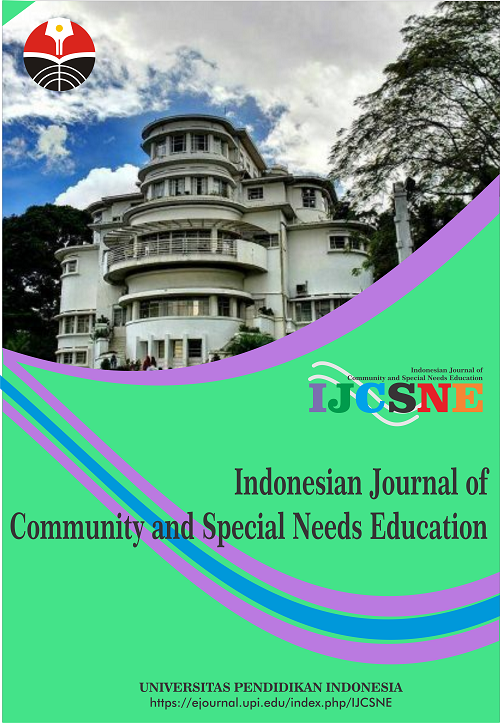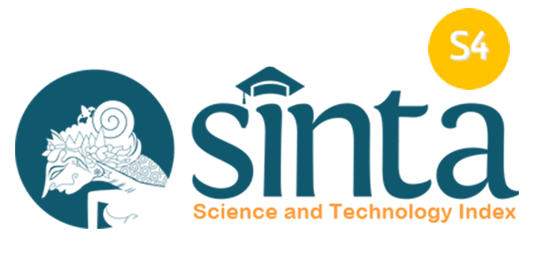Secondary School Violence Among Adolescents: The Contributing Factors and Way Forward
Abstract
Keywords
Full Text:
PDFReferences
Adewuyi, H. O. (2023). Predictors of bullying among adolescents: A critical study of the parenting processes, neighbourhood influence, and the school. Multicultural Education Journal, 9(2), 1-15.
Adewuyi, H. O., Jimoh, A. M., and Falaye, A. O. (2020). The predictive influence of self-compassion, social support, social media and gender on self-acceptance among school going adolescents in Oyo state. Journal of Positive Psychology and Counselling, 6, 146-157.
Afolashade, I., Jimoh, A., Raji, N., Fowowe-Ogunmilugba, B., Oduola, O., and Adewuyi, H. (2023). Emotional intelligence, job satisfaction, reward system and organizational commitment among workers. ASEAN Journal of Economic and Economic Education, 3(1), 45-60.
Awopeju, O. A., Afolabi, E. R. I., and Opesemowo, O. A. (2017). An investigation of invariance properties of one, two and three parameter logistic item response theory models. Bulgarian Journal of Science and Education Policy, 11(2), 197-219.
Bonal, X., and González, S. (2020). The impact of lockdown on the learning gap: Family and school divisions in times of crisis. International Review of Education, 66, 1–21.
Bradshaw, C. P., Sawyer, A. L., and O’Brennan, L. M. (2010). The relationship between bullying and school climate in middle schools. Journal of Educational Psychology, 102(1), 31-40.
Brennan, R. A., and Bossong, A. R. (2016). The role of socio-economic status in school violence. Journal of School Violence, 15(2), 195-206.
Brown Griffin, C., Metzger, I. W., Halliday-Boykins, C. A., and Salazar, C. A. (2020). Racial fairness, school engagement, and discipline outcomes in African American high school students: The important role of gender. School Psychology Review, 49(3), 222–238.
Carolan B. V., and Wasserman S. J. (2015). Does parenting style matter? concerted cultivation, educational expectations, and the transmission of educational advantage. Sociological Perspectives, 58, 168–186.
Chen, X., and Rosen, L. D. (2011). Neighborhood disadvantage and adolescent dating violence. Journal of Adolescent Health, 48(3), 270-277.
Devries, K., Knight, L., Petzold, M., Merrill, K. G., Maxwell, L., Williams, A., and Abrahams, N. (2018). Who perpetrates violence against children? A systematic analysis of age-specific and sex-specific data. BMJ Paediatrics Open, 2(1), e000180.
Dorn, S., and Fiore, A. (2013). Building positive school climate to improve student outcomes. Journal of Educational Research, 106(5), 314-323.
Egan, V., and Siever, M. (2014). Peers and delinquency: An examination of the social influence process. Journal of Criminal Justice, 42(3), 279-288.
Elianny, E. C. (2021). Centering race to move towards an intersectional ecological framework for defining school safety for black students. School Psychology Review, 50(2-3), 254–273.
Forber-Pratt, A. J., El Sheikh, A. J., Robinson, L. E., Espelage, D. L., Ingram, K. M., Valido, A., and Torgal, C. (2021). Trauma-informed care in schools: Perspectives from school resource officers and school security professionals during professional development training. School Psychology Review, 50(2-3), 344-359.
Garner, P. (2014). Dimensions of school-based violence to and by children: An overview of recent literature. International Journal of Adolescence and Youth, 19(4), 484-495.
Gkatsa, T., Magklara, K., Bellos, S., Damigos, D., Mavreas, V., and Skapinakis, P. (2015). Sociodemographic associations of school-related bullying and its impact on psychosomatic health in adolescents. Archives of Hellenic Medicine/Arheia Ellenikes Iatrikes, 32(2), 182.
Glew, G. M., Fan, M. Y., Katon, W., Rivara, F. P., and Kernic, M. A. (2005). Bullying, psychosocial adjustment, and academic performance in elementary school. Archives of Pediatrics and Adolescent Medicine, 159(11), 1026-1031.
Hildenbrand, A. K., Daly, B. P., Nicholls, E., Brooks‐Holliday, S., and Kloss, J. D. (2013). Increased risk for school violence‐related behaviors among adolescents with insufficient sleep. Journal of school health, 83(6), 408-414.
Hirschfield, P. J. (2018). Schools and crime. Annual Review of Criminology, 1, 149-169.
Hornby, G., and Blackwell, I. (2018). Barriers to parental involvement in education: An update. Educational Review, 70(1), 109-119.
Jenkins, L. N., and Nickerson, A. B. (2019). Bystander intervention in bullying: Role of social skills and gender. The Journal of Early Adolescence, 39(2), 141-166.
Jiang, S., Li, C., and Fang, X. (2018). Socioeconomic status and children's mental health: Understanding the mediating effect of social relations in Mainland China. Journal of Community Psychology, 46(2), 213-223.
Kanmodi, K., O. Fagbule, K. Ogunniyi, M. Ogbeide, V. Samuel, E. Aliemeke, Y. Olatunji,T. Isola, Habeeb O. Adewuyi, and S. Musa (2020). Determinants of sexual practices among secondary school students in nigeria: Focusing on socio-cultural and school-related factors. Rwanda Medical Journal, 77(4), 32-37.
Laursen, B. and Veenstra, R., 2021. Toward understanding the functions of peer influence: a summary and synthesis of recent empirical research. Journal of Research on Adolescence, 31(4), 889–907.
Leemis, R. W., Espelage, D. L., Basile, K. C., Mercer Kollar, L. M., and Davis, J. P. (2019). Traditional and cyber bullying and sexual harassment: A longitudinal assessment of risk and protective factors. Aggressive Behavior, 45(2), 181-192.
Lenhardt, A. M. C., Graham, L. W., and Farrell, M. L. (2018). A framework for school safety and risk management: Results from a study of 18 targeted school shooters. The Educational Forum, 82(1), 3-20.
Lynch, C. G., Gainey, R. R., and Chappell, A. T. (2016). The effects of social and educational disadvantage on the roles and functions of school resource officers. Policing: An International Journal of Police Strategies and Management, 39(3), 521–535.
Mehari, K. R., Thompson, E. L., and Farrell, A. D. (2020). Differential longitudinal outcomes of in-person and cyber victimization in early adolescence. Psychology of Violence, 10(4), 367-378.
Mihalic, H. and Elliot V., (2004). If your friends jumped off of a bridge, would you do it too: Delinquent peers and susceptibility to peer influence. Justice Quarterly, 27, 473–491.
Mouton, N., Louw, G. P., and Strydom, G. (2013). Critical challenges of the South African school system. International Business and Economics Research Journal (IBER), 12(1), 31-44.
Ncontsa, V. N., and Shumba, A. (2013). The nature, causes and effects of school violence in South African high schools. South African Journal of Education, 33(3), 1-15.
Omoponle, A. H. (2023). Delinquency among senior secondary school adolescents: Psycho-personological factors: Psycho-personological factors. International Journal of Curriculum and Instruction, 15(3), 2145-2165.
Omoponle, A. H., and Veronica, D. (2023). Risky sexual behavior and associated factors among in-school adolescents: A school-based, cross-sectional study. EUREKA: Social and Humanities, (4), 59-68.
Onyemah, T. N., and Omoponle, A. H. (2022). Child abuse and family background as predictors of poor academic performance among adolescents in special schools of Ibadan-Nigeria. Journal of Lexicography and Terminology, 6(1), 106-119.
Opesemowo, O. A., Afolabi, E. R. I., Awopeju, O. A., and Oluwatimilehin, T. R. (2018). Development of a scale for measuring students' testwiseness in senior secondary school examination in Nigerian. International Journal of Research, 5(19), 464-474.
Pereznieto, P., Harper, C., Clench, B., & Coarasa, J. (2010). The economic impact of school violence: A report for plan international. Overseas Development Institute, 8(6), 2-101.
Poipoi, M. W. U., Agak, J. O., and Kabuka, E. K. (2011). Perceived home factors contributing to violent behaviour among public secondary school students in western province, Kenya. Journal of Emerging Trends in Educational Research and Policy Studies, 2(1), 30-40.
Smith, J. (2017). The impact of school climate on school violence. Journal of Education, 32(2), 1-15.
Smokowski, P. R., Evans, C. B., Rose, R., and Bacallao, M. (2020). A group randomized trial of school-based teen courts to address the school to prison pipeline, reduce aggression and violence, and enhance school safety in middle and high school students. Journal of School Violence, 19(4), 566-578.
Sylvester E. U., Adewuyi H. O., Falaye A. O., Adegoke S. A., and Raji N. A. (2023). Sexual promiscuity among students in tertiary institutions: Interrogating the roles of peer influence, parenting processes, social economic status and social media. World Journal of Advanced Research and Reviews, 20(02), 132–143.
Thapa, A., Cohen, J., Guffey, S., and Higgins-D’Alessandro, A. (2013). A review of school climate research. Review of Educational Research, 83(3), 357-385.
Tippett, N., and Wolke, D. (2014). Socioeconomic status and bullying: A meta-analysis. American Journal of Public Health, 104(6), e48-e59.
Wang Y. J., Deng C. P., and Yang X. D. (2016). Family economic status and parental involvement: influences of parental expectation and perceived barriers. School Psychology International, 37(5), 536–553.
Wentzel, K. R. (2009). Social relationships and motivation in middle school: The role of parents, teachers, and peers. Journal of Educational Psychology, 101(2), 399-417.
DOI: https://doi.org/10.17509/ijcsne.v4i2.67257
Refbacks
- There are currently no refbacks.
Copyright (c) 2024 Universitas Pendidikan Indonesia

This work is licensed under a Creative Commons Attribution-ShareAlike 4.0 International License.















